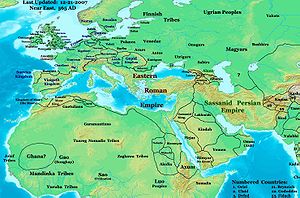Kingdom of Kinda
The kingdom of Kindah (كندة) was a vassal kingdom which ruled from Qaryah dhat Kahl in Nejd, Central Arabia (present-day Saudi Arabia). The kingdom controlled much of the northern Arabian peninsula in the 4th and 5th centuries AD.

Origin
The Kindah tribe was a Kahlani branch of the Sabaean Kingdom of Marib (central Yemen) in the early 3rd century AD. They played a major role in the Sabaean-Hadramite war. With the Sabaean victory, a branch of Kindah established themselves in Hadramout, and the majority of Kindah returned to their lands to the east of Marib.
Migration out of Yemen
After the collapse of the Marib Dam and the Himyari's final annexation of Saba'a, the Kindites headed towards ancient Bahrain but were expelled by the Abdul Qais tribe. The Kindites returned to Yemen, leaving a branch of Kindah in modern Jabal Shammar in Nejd, the Levant and Iraq.
Return to Yemen
When some of the Kindites returned to Yemen in the 4th century AD, the Himyarites were at the height of their power, having annexed Hadramout, the last rival South Arabian kingdom. The Kindites had historic feuds with the Hadramite tribes of the southern Wadi, so they were settled in Northern Hadramout and were given authority over Hadramout by the Himyarites. From this point on, some Arab historians consider Kindah to have been part of the Himyar tribal federation.
Kindite kings in Hadramout 325AD–425AD
- Muwiyah Ibn Mutri
- Murti ibn Muawiyah
- Muawiyah ibn Thaur
- Amr ibn Muawiyah
- Muawiyah ibn Rabiah
- Hijr Ibn Muwaiyah
Expansion towards Northern Arabia
In the 5th century AD, the Adnani tribes of the North became a major threat to the trade line between Yemen and Syria. The Himyarites decided to establish a vassal state that controlled Central and North Arabia. The Kindites gained strength and numbers to play that role, and in 425 AD the Himyarite king Hasan ibn Amr ibn Tubba’ made Hujr Akil al-Murar ibn Amr the first King (Hujr) of Kindah.
Kindite Kings ruling from Nejd 425AD–528AD
- Hujr Akil al-Murar ibn Amr 425-458
- Amr al-Mansur ibn Hudjr 458-489
- Al-Harith Talaban ibn Amr 489-528
Wars with the Lakhmids
In that period the Ghassanids, Lakhmids and Kindites were all Kahlani and Qahtani vassal kingdoms appointed by the Byzantines, Persians and Himyarites to protect their borders and imperial interests from the raids of the then-rising threat of the Adnani tribes. The Kindites were the most successful in pacifying the Adnani tribes of Central Arabia through alliances, and focused on wars with the Lakhmids.
The fall of Himyar
In 525 AD, the Aksumites invaded Himyar, and the Kindites gradually declined. Within three years the Kindite kingdom had split into several smaller kingdoms, which were subsequently destroyed in the 530s and 540s in a series of uprisings of the Adnani tribes of Najd and Hijaz.
Imru' Al-Qais and the return to Hadramawt
Among the most famous Kindites is Imru' al-Qais, who was not only a son of one of the last Kindite kings (and unsuccessfully tried to resurrect his father's kingdom), but also the most prominent pre-Islamic Arab poet. It was during Al-Qais' time, in 540 AD, that the Lakhmids destroyed all the Kindite settlements in Nejd, forcing them to move back to the Hadramawt with the Aksumites (Aksum) in Western Yemen. The Kindites and most the Arab tribes switched their alliances to the Lakhmids.
Jewish conversion
The conversion of the Himyarite kings to Judaism in the late 5th century AD led to the conversion to Judaism of the Kindites. However, the transition of the power in Yemen to Christian Aksumites in 525 AD appears to have undermined Kindite Judaism in the most significant way.
Descendants of the Kindites
Today, most Kindites live in Yemen, Oman,[1] Iraq, the United Arab Emirates, Saudi Arabia, Syria, Jordan, southern Algeria, Indonesia, Singapore, Malaysia and Southern Philippians.
See also
Notes
- ^ Al Owtabi Al Sohari, Salama bin Muslim (1994). Al Ansaab part:1. Muscat: Ministry of Haritage & Culture, Oman. p. 392.
